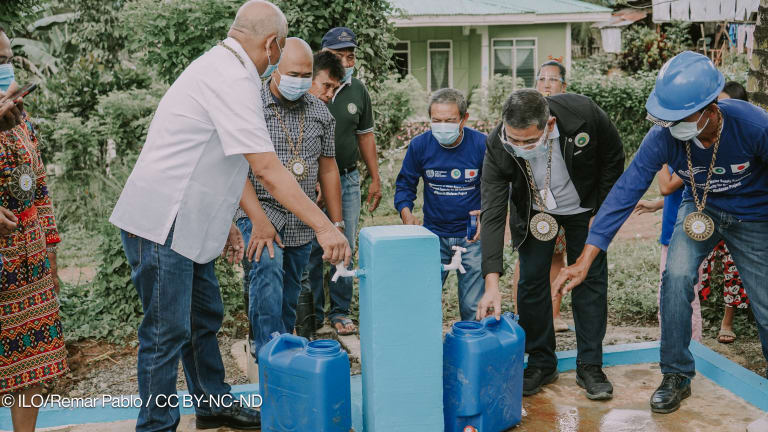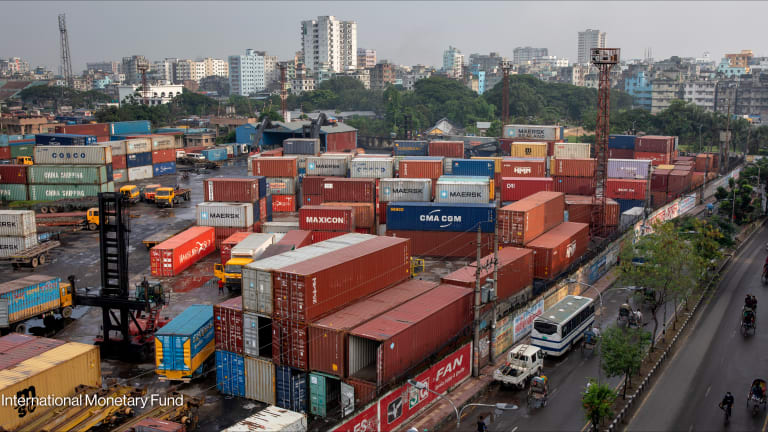Which countries are the most dependent on ODA?
Devex analysis finds the countries that are most dependent on ODA are either Pacific island nations hampered by their location or sub-Saharan African states crippled by past conflicts.
Devex first asked this question and undertook the exercise of determining the countries that are most dependent on official development assistance using 2010 data from the Organization for Economic Cooperation and Development — the most recent figures available at the time — in 2012. Seven out of the 10 countries that made it in the previous list also appear in our list below, this time based on 2012 OECD data. All the countries in the current list are either Pacific island nations hampered by their location or sub-Saharan African countries crippled by past conflicts — a reality that points to the different kinds of vulnerabilities countries could face and make them rely heavily on ODA. Solomon Islands Despite being classified as a lower-middle-income country by the World Bank in 2011, Solomon Islands still largely relies on foreign aid: net ODA made up as much as 44 percent of the Pacific island country’s gross national income in 2012. Australia ($239 million), New Zealand ($25 million) and Japan ($20 million) — traditionally the largest donors to the Solomon Islands — were the same major donors that year. Solomon Islands’ heavy dependence on ODA, however, seems to have stirred corruption claims among the country’s top ranks. Earlier this year, local nongovernmental organizations called for an “aid freeze” from donors amid alleged embezzlement involving the government — a strong accusation that, if true, runs counter to the rhetoric behind Solomon Islands Prime Minister Gordon Darcy Lilo’s “zero tolerance for corruption” policy. Tuvalu With its islands dotted across the South Pacific, tiny Tuvalu is vulnerable to natural and economic shocks and has few options for generating domestic revenue because of its isolation. The Tuvalu Trust Fund, which was set up in 1987 by Australia, New Zealand and the United Kingdom to help fund basic services for Tuvaluans, has contributed to the sale of tuna fishing licenses and the lease of Tuvalu’s .tv Internet domain as one reliable revenue source. But despite these innovative income sources, Tuvalu remains dependent on foreign aid. Australia ($12 million), Japan ($9 million) and New Zealand ($4 million) were Tuvalu’s top donors in 2012. Around 25 percent of bilateral ODA to Tuvalu, meanwhile, went to education. Liberia Years of conflict have left Liberia quite literally in the dark. Liberia’s power sector, already severely damaged at the end of the civil war in 2003, had been destroyed even more by looting. According to the World Bank, in mid-2011, a measly 0.58 percent of the Liberian capital city’s population had access to electricity. Upon assuming office in 2010, Liberia President Ellen Johnson Sirleaf famously declared that “Liberia should not need aid in 10 years.” With net ODA making up 35.4 percent of its GNI in 2012 — a significant improvement from its 176.8 ODA-to-GNI ratio in 2010 — Liberia still seems far from the lofty goal. In 2012, Sirleaf announced another goal that seemed equally daunting: to connect 30 percent of Liberia’s urban population and 15 percent of the rural population to the national grid by 2015. While the 2015 deadline may be too optimistic, the United States ($181 million), Japan ($134 million), European Union ($94 million), Germany ($63 million) and the World Bank ($52 million) — Liberia’s largest donors in 2012 — are helping Liberia meet this target. Marshall Islands Through the Compact of Free Association, the United States gives substantial funding to the Marshall Islands — among its top trading partners — to set the latter on a path toward economic self-sufficiency post-2023. Because of this relationship, financial assistance from the United States ($67.4 million) in 2012 dwarfed other donors like Japan ($8.1 million) and Australia ($5.4 million) — two countries that usually give the most aid to Pacific island countries. U.S. aid has generally focused on education, health and infrastructure, but under the amended compact, the donor country will also provide the Marshall Islands with around $70 million a year until fiscal 2023. This amount includes contributions to a jointly managed trust fund and financial assistance from U.S. federal grants. Micronesia Like the Marshall Islands, Micronesia is part of the Compact of Free Association. Again eclipsing Japan ($18.19 million) and Australia ($4.86 million), the United States ($98.32 million) was Micronesia’s top donor in 2012. The amended compact notes that grant assistance will focus on education, health, infrastructure, public sector capacity building, private sector development and the environment. More than $130 million in direct assistance, which includes federal grants and services, will come from the United States every year — an amount that will be sustained until 2023 to steer Micronesia toward economic self-sufficiency. Malawi Beset by a heavy disease burden, Malawi suffers from high levels of child and adulthood mortality as well as high prevalence of malaria, tuberculosis and HIV. The World Health Organization noted that there has also been an increasing number of Malawians afflicted with noncommunicable diseases. In 2012, around 40 percent of bilateral ODA to Malawi went to health and population. Among Malawi’s largest donors that year were the United States ($170 million), the United Kingdom ($151 million), the World Bank ($116 million), European Union ($104 million) and the Global Fund to Fight AIDS, Tuberculosis and Malaria ($97 million). Kiribati Kiribati, a low-lying Pacific island country, announced in 2012 that it was considering moving its population to Fiji’s Vanua Levu island because of the threat of rising sea levels. At the U.N. General Assembly’s General Debate in September 2012, Kiribati President Anote Tong appealed to the country’s development partners to continue to support Kiribati and enable it to “migrate with dignity should the time come that migration is unavoidable.” Australia ($36 million), New Zealand ($13 million) and Japan ($11 million) were Kiribati’s top donors in 2012. Almost 40 percent of bilateral ODA to Kiribati was channeled toward economic infrastructure and services that year. Burundi The assassination of Melchior Ndadaye, Burundi’s first democratically elected and Hutu head of state, plunged Burundi into a 12-year civil war — one that exacerbated poverty in a country that was already among the world’s poorest even before the conflict started. Emerging from the long period of instability in 2005, Burundi has since successfully disarmed soldiers and former rebels. It has also made some progress toward the Millennium Development Goals. But Burundi, despite much support from donors like the World Bank ($100 million), European Union ($73 million) and Belgium ($61 million) in 2012, is unlikely to meet them. South Sudan Even before it was declared independent in 2011, South Sudan already leaned heavily on aid. A year after it became the world’s youngest country, it had the United States ($740 million), the United Kingdom ($128 million), Norway ($67 million), Canada ($57 million) and Japan ($50 million) as its five major donors. Nearly 50 percent of bilateral ODA to South Sudan was devoted to humanitarian aid in 2012. As South Sudan teeters on the brink of a famine, the need for humanitarian assistance remains high, but long-term development needs must not be overlooked. Samoa In 2012, Cyclone Evan caused damage worth $300 million in Samoa, prompting the Australian government to donate an initial 1 million Australian dollars ($940,000) in emergency assistance. One of the major donors to Samoa, Australia ($40 million) was the Pacific island country’s largest provider of foreign assistance that year. Education — an important area as the Samoan economy becomes more integrated into the global economy in the next 10 years — made up more than 30 percent of bilateral ODA to Samoa in 2012. In this sector, Australia was also the top donor, supporting better education for boys, girls and children with special needs. Check out more practical business and development advice online, and subscribe to Money Matters to receive the latest contract award and shortlist announcements, and procurement and fundraising news.
Devex first asked this question and undertook the exercise of determining the countries that are most dependent on official development assistance using 2010 data from the Organization for Economic Cooperation and Development — the most recent figures available at the time — in 2012.
Seven out of the 10 countries that made it in the previous list also appear in our list below, this time based on 2012 OECD data. All the countries in the current list are either Pacific island nations hampered by their location or sub-Saharan African countries crippled by past conflicts — a reality that points to the different kinds of vulnerabilities countries could face and make them rely heavily on ODA.
Despite being classified as a lower-middle-income country by the World Bank in 2011, Solomon Islands still largely relies on foreign aid: net ODA made up as much as 44 percent of the Pacific island country’s gross national income in 2012. Australia ($239 million), New Zealand ($25 million) and Japan ($20 million) — traditionally the largest donors to the Solomon Islands — were the same major donors that year.
This story is forDevex Promembers
Unlock this story now with a 15-day free trial of Devex Pro.
With a Devex Pro subscription you'll get access to deeper analysis and exclusive insights from our reporters and analysts.
Start my free trialRequest a group subscription Printing articles to share with others is a breach of our terms and conditions and copyright policy. Please use the sharing options on the left side of the article. Devex Pro members may share up to 10 articles per month using the Pro share tool ( ).
Anna Patricia Valerio is a former Manila-based development analyst who focused on writing innovative, in-the-know content for senior executives in the international development community. Before joining Devex, Patricia wrote and edited business, technology and health stories for BusinessWorld, a Manila-based business newspaper.








